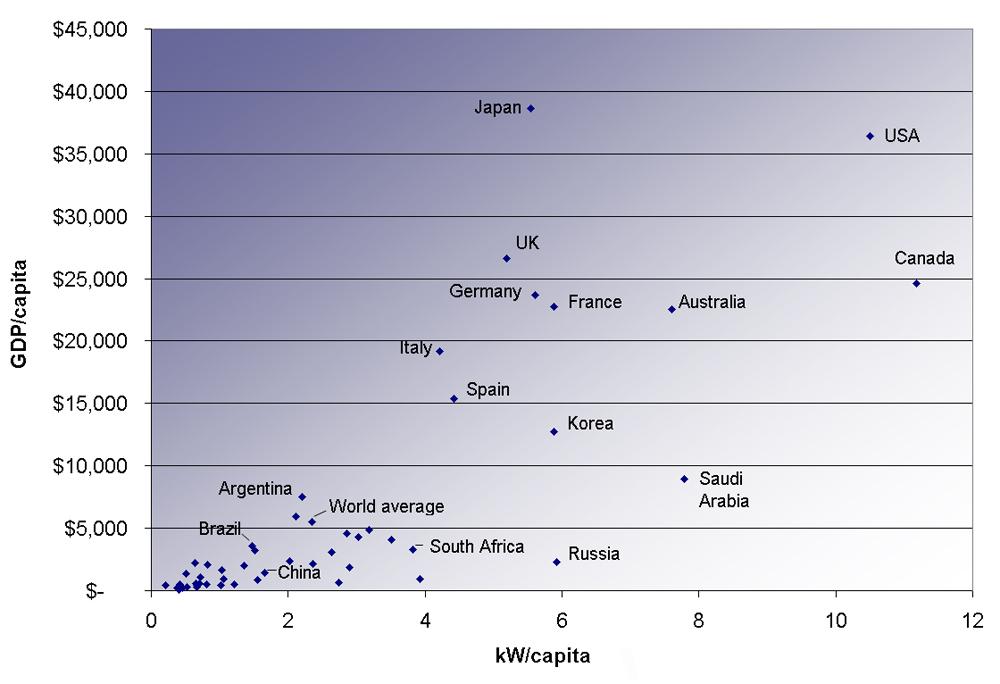The World’s Growing Energy Needs
World energy consumption continues to rise, especially in developing countries (see Figure 7.31). Global demand for energy has tripled in the past 50 years and might triple again in the next 30 years. While much of this growth will come from the rapidly booming economies of China and India, many of the developed countries, especially those in Europe, are hoping to meet their energy needs by expanding the use of renewable sources. Although presently only a small percentage, renewable energy is growing very fast, especially wind energy. For example, Germany plans to meet 20 percent of its electricity and 10 percent of its overall energy needs with renewable resources by the year 2020 (see Figure 7.32). Energy is a key constraint in the rapid economic growth of China and India. In 2003, China surpassed Japan as the world’s second largest consumer of oil. However, over 1/3 of this is imported. Unlike most Western countries, coal dominates the commercial energy resources of China, accounting for 2/3 of its energy consumption. In 2009, China surpassed the United States as the largest generator of . In India, the main energy resources are coal and biomass—for example, wood and dung. Half of India’s oil is imported. About 70 percent of India’s electricity is generated by highly polluting coal. Yet there are sizeable strides being made in renewable energy. India has a rapidly growing wind energy base, and it has the largest solar cooking program in the world.
Table 7.6 displays the 2006 commercial energy mix by country for some of the prime energy users in the world. While non-renewable sources dominate, some countries get a sizeable percentage of their electricity from renewable resources. For example, about 67 percent of New Zealand’s electricity demand is met by hydroelectric. Only 10 percent of the U.S. electricity is generated by renewable resources, primarily hydroelectric. It is difficult to determine total contributions of renewable energy in some countries with a large rural population, so these percentages in this table are left blank.
| Country |
Consumption, in EJ (1018 J) |
Oil |
Natural Gas |
Coal |
Nuclear |
Hydro |
Other Renewables |
Electricity Use per Capita (kWh/y) |
Energy Use per Capita (GJ/y) |
| Australia |
5.4 |
34% |
17% |
44% |
0% |
3% |
1% |
10,000 |
260 |
| Brazil |
9.6 |
48% |
7% |
5% |
1% |
35% |
2% |
2,000 |
50 |
| China |
63 |
22% |
3% |
69% |
1% |
6% |
|
1,500 |
35 |
| Egypt |
2.4 |
50% |
41% |
1% |
0% |
6% |
|
990 |
32 |
| Germany |
16 |
37% |
24% |
24% |
11% |
1% |
3% |
6,400 |
173 |
| India |
15 |
34% |
7% |
52% |
1% |
5% |
|
470 |
13 |
| Indonesia |
4.9 |
51% |
26% |
16% |
0% |
2% |
3% |
420 |
22 |
| Japan |
24 |
48% |
14% |
21% |
12% |
4% |
1% |
7,100 |
176 |
| New Zealand |
0.44 |
32% |
26% |
6% |
0% |
11% |
19% |
8,500 |
102 |
| Russia |
31 |
19% |
53% |
16% |
5% |
6% |
|
5,700 |
202 |
| U.S. |
105 |
40% |
23% |
22% |
8% |
3% |
1% |
12,500 |
340 |
| World |
432 |
39% |
23% |
24% |
6% |
6% |
2% |
2600 |
71 |
Table 7.6 Energy Consumption—Selected Countries (2006)




